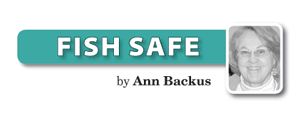Before the mayday distress call existed, that is before the radio as we know it was in use, telegraph operators used the Morse Code signal — three dots, three dashes, three dots — to communicate distress.
The sound of the tapped dots and dashes are often expressed as dih, dih, dih, dah, dah, dah, dih, dih dih. Many of you associate this collection of dots and dashes as the letters SOS in Morse Code.
 However, according to historians of communication, the letters SOS have no meaning. They do not stand for “save our ship’, for example. They just happen to be Morse code for S (dot dot dot) and O (dash, dash, dash).
However, according to historians of communication, the letters SOS have no meaning. They do not stand for “save our ship’, for example. They just happen to be Morse code for S (dot dot dot) and O (dash, dash, dash).
The SOS signal was ratified as a distress signal in 1908 and was used by telegraph operators on land, and eventually onboard vessels, when “wireless telegraphy” was available.
Fast-forward to the 1920’s when wireless telegraphy became known as radio.
By this time, transmission and reception of the signal was good enough to make out words spoken by the human voice.
It is easy to understand that radio officers were looking for a word, a voice communication, to indicate distress, which would presumably take the place of the dih, dih, dih, dah, dah, dah, dih, dih dih sounds of the telegraph.
According to Wikipedia, Frederick Stanley Mockford, the radio officer asked to find this word, came up with “mayday.”
Why this word? Well, it is from the French word “m’aider” literally meaning, “help me.”
At the International Radiotelegraph Conference, held in November 1927 in Washington, DC, a resolution was passed (Article 11) directing “that the International Conference on the Safety of Life at Sea should prepare a system of international rules with the least possible delay.”
An additional resolution, Article 19, titled, “Distress, alarm, urgency, and safety signals” in Section 2(1) mentions the SOS as a distress signal, discusses that a distress call includes the SOS signal, plus DE, plus the call sign of the mobile station (on board the ship, in this case) and states that this call has “absolute priority over all other transmissions.”
In Section 2(2) the text reads, “The same rules apply to the radiotelephone distress call which consists of the spoken expression mayday (corresponding to the French pronunciation of the expression “m’aider”).”
At the same convention, the urgency signal PAN, which we use today as PAN-PAN, (French, panne, breakdown) was discussed. The urgency signal PAN has priority over all other transmissions except the distress signal mayday, which is understood to indicate a life-threatening situation.
Today’s captains and crew are schooled in how make mayday and PAN-PAN calls. They know that VHF Channel 16 is reserved for these calls, and that anyone making an initial call on Channel 16 must choose another frequency immediately for non-distress, non-urgent communication. Sometimes the captain has time to make a mayday call when lives are in danger, but sometimes he/she does not.
Here in New England, we recently experienced a sad loss of life when the crew of the 82’ fishing vessel Emmy Rose apparently had no time, or for some reason couldn’t call, “mayday, mayday, mayday” on Channel 16.
The Coast Guard heard the boat’s EPIRB ping at 1 am on Nov. 23 and responded north of Provincetown, MA with a helicopter crew and the cutter Vigorous.
They found only debris and an empty liferaft.
The fishermen had been on their way back to Gloucester with a boatload of groundfish when tragedy overtook them.
In that incident we lost four experienced Maine fishermen: Jeff Matthews, Ethan Ward, Michael Porper, and skipper Robert Bethen.
Our condolences go out to the families and friends of these courageous fishermen who were making their final trip before Thanksgiving.
In contrast, there are also times when not to use the mayday distress call.
On Dec. 3, the Maine Marine Patrol from Rockland and a Coast Guard crew from Cape Cod headed out to search for a 42’ fishing vessel that had made a mayday call on Channel 16 at 6:30 am.
The caller had provided details about flooding aboard the boat, but after 24 hours of searching 62 square nautical miles of ocean near Spruce Head, ME, and finding no corroborating evidence, the Coast Guard called off the search and classified the call as a hoax.
This is when not to use a mayday distress call. Mayday is reserved for real distress and life-threatening situations.
Capt. Brian LeFebvre, commanding officer of Coast Guard Sector Northern New England, as quoted in the Mount Desert Islander, said, “Hoax distress calls … unnecessarily put our rescue crews at risk, drain resources, and may limit our ability to respond to actual emergencies. Today’s hoax is particularly offensive given the loss of four fishermen aboard the Emmy Rose just last week.”
A false distress call is a felony under federal law.
It carries a $250,000 fine, a $10,000 civil penalty, and possible assignment of other costs based on the costs incurred by the responding units. A prison sentence of up to six years is also possible.
Ann Backus, MS, is the director of outreach for the Harvard School of Public Health’s Department of Environmental Health in Boston, MA. She may be reached by phone at (617) 432-3327 or by e-mail at <abackus@hsph.harvard.edu>.
References:
www.en.wikipedia.org/wiki/Mayday
www.itu.int/en/history/pages/RadioConferences.aspx
www.mdislander.com/maine-news/waterfront
FISH SAFE
• Know how to make mayday and PAN-PAN calls.
• Make these calls only in life-threatening and urgent situations, respectively.
• Honor the fact that our first responders must respond to every call they receive.






